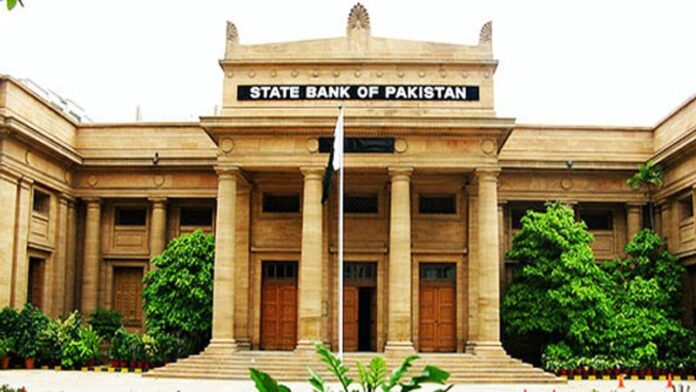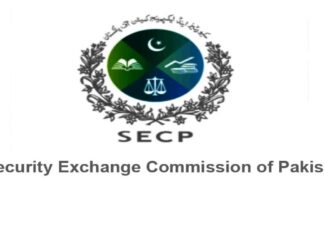KARACHI: The State Bank of Pakistan (SBP) announced a 100 bps hike in the policy rate in conclusion to Tuesday’s Monetary Policy Committee (MPC) meeting, aiming to “counter inflationary pressures” and “ensure growth that remains sustainable”.
While the term forward guidance has not been used in the statement, the MPC has said, “Following today’s rate increase and given the current outlook for the economy, and in particular for inflation and the current account, the MPC felt that the end goal of mildly positive real interest rates on a forward-looking basis was now close to being achieved. Looking ahead, the MPC expects monetary policy settings to remain broadly unchanged in the near-term.”
Tahir Abbas, Head of Research at Arif Habib Limited says, “The most important elemant is the forward guidance by the SBP in which MPC felt that the end goal of mildly positive interest rates on forward looking basis has almost been achieved and the monetary policy is expected to broadly remain unchanged in the near term.”
Earlier last month, in an exclusive interview with Profit, SBP Governor Reza Baqir explained, “In terms of the stance of monetary policy has not been tightened, just the pace at which you want to reach that in our view is faster. The reason it should be faster is because the rotation of balance of risks from growth to inflation and the current account has been a bit faster than anticipated. Now that message has information that is positive and also contains information, which has prompted us to the fact that growth continues to be robust. Even with this policy action, we expect growth to 5 per cent this fiscal year.”
The frequency of MPC meetings has increased because “the two month period proved to be quite long when the world is changing rapidly,” said the governor.
Market Expectations
As per the Bloomberg MPC survey, the median estimate was 9.75pc in line with the SBP’s decision.
Standard Chartered Bank (SCB) and Ismail Iqbal Securities estimated a 50 bps increase whereas, Dawood Equities estimated a 200 bps increase. Only 4 of the 47 surveyed estimated a hike of less than 100 bps which shows the market anticipated a somewhat aggressive hike.
This is important considering the speculation and haphazard way in which money, debt, and capital markets have been operating over the uncertainty regarding the policy rate.
The MPC has called the uncertainty and reaction of market players as “unwarranted”. The statement reads, “across all tenors, secondary market yields, benchmark rates and cut-off rates in the government’s auctions have risen significantly. The MPC noted that this increase appeared unwarranted.” Thus, the forward guidance provided remains important keeping market sentiments in mind.
“In my view, the forward guidance will reduce uncertainty in the money market,” Pak Kuwait Investment Company Head of Research Samiullah Tariq said.
It is interesting to note that the finance minister also had a dressing down for banks for their greed and went live on television to say, “We’re speaking to the banks tomorrow. We’re going to explain to them that they shouldn’t do such antics.”
If you’re interested to know what the antics are, give this a read. The 3 month treasury bill is 200 bps higher than the policy rate. As a result, on the Dec 1 T-bill auction, the government raised Rs500 billion at a much higher rate than their previous auction where the government accepted much lower bids. This showed that the market was expecting the policy rate to go higher much faster which put the SBP’s accommodative stance into question and whether it would be strung along by banks.
“The increase was expected and despite growing pressure on the SBP to go easy, the language of the MPC indicates that more hikes are around the corner,” says Uzair Younus, Director of the Pakistan Initiative at the Atlantic Council.
Another comment on the statement comes in from Ammar Habib Khan, Economist who sarcastically comments, “Mildly amused and amusement on a forward looking basis is expected to remain broadly unchanged in near term.”
Inflation still a concern
“The momentum in inflation has continued since the last MPC meeting, as reflected in a significant increase in both headline and core inflation in November. Due to recent higher than expected outturns, SBP expects inflation to average 9 – 11 percent this fiscal year.”
“Since the last meeting on 19th November 2021, indicators of activity have remained robust while inflation and the trade deficit have risen further due to both high global prices and domestic economic growth.
Headline inflation clocked in at 11.5% year on year and core inflation increased to 7.6% and 8.2% for urban and rural areas signifying accelerated growth in domestic demand.
The policy statement identified electricity charges, motor fuel, house rent, milk, and vegetable ghee as the largest contributors towards inflation.
“Looking ahead, based on this momentum and the expected path of energy tariffs, inflation is likely to remain within the revised forecast range for the remainder of the fiscal year. Subsequently, as global commodity prices retrench, administered price increases dissipate, and the impact of demand-moderating policies materialises, inflation is expected to decline toward the medium-term target range of 5-7 per cent during FY23.”
Fahad Rauf, Head of Research at Ismail Iqbal Securities explains,” It is evident that the SBP is mainly targeting inflation. If inflation remains above SBP expectations, it would pose upside risks to interest rates.”
Real Sector
As per the MPC the real sector continues to grow.
“High-frequency indicators of domestic demand released since the last meeting, including electricity generation, cement dispatches, and sales of fast-moving consumer goods and petroleum products, and continued strength in imports and tax revenues suggest that economic growth remains robust. The outlook for agriculture continues to be strong, supported by better seed availability and an expected increase in the area under wheat cultivation.
Meanwhile, robust growth in sales tax on services also suggests that the tertiary sector is recovering well.”
While speaking to profit earlier, Baqir explained, “We are not doing this at a time when the economy is slowing down, there is a fundamental difference between this phase of monetary tightening, what I would say, reduction of accommodation and the one in 2019.
At that point, the economy was slowing, but there was a much bigger problem of stabilization. This is a stage of moderating, the extent of growth. This is the stage of taking steps to prevent overheating. This is the stage to get out of the history of boom-bust cycles. We have had growth before, but where we have not been very successful in sustaining growth.”
External Sector
“On the external side, despite record exports, high global commodity prices contributed to a significant increase in the import bill. As a result, the November trade deficit rose to $5 billion based on PBS data,” said the report.
Imports rose to $32.9 billion during the fiscal year compared to $19.5 billion for the same period last year. “Around 70 per cent of this increase in imports stems from the sharp rise in global commodity prices, while the rest is attributable to stronger domestic demand,” says the statement.
On Monday, remittances registered meager 1pc year-on-year (YoY) growth, clocking in at $2.4 billion in November FY22 compared with $2.3 billion during November FY21. The impact of the remittances on the Current Account Deficit (CAD), due to be released in the coming days can also be witnessed.
The CAd is projected at 4 per cent of the GDP, which is higher than earlier projected.
The MPC feels the steps taken to arrest the deterioration in the current account deficit have been timely.
“The MPC noted that the current account deficit is expected to be fully financed from external inflows. As a result, foreign exchange reserves should remain at adequate levels through the rest of the fiscal year and resume their growth trajectory as global commodity prices ease and import demand moderates.”
Fiscal Sector
During July-November FY22, fiscal revenue growth has been strong, driven by a broad-based and above target increase in FBR tax collections (36.5 per cent YoY).
However, the decision to forgo petroleum development levy led to a decline in non tax revenues by 22.6 per cent over last year.
While there is greater expenditure in terms of subsidies and grants, the government aims to increase its revenues through elimination of certain tax exemptions and reduce current and development expenditures. This is in line with austerity measures pushed by the IMF.

























Expect another rate hike by 02.5 – 0.5% in the next MPC announcement as it will be in line with “MPC expects monetary policy settings to remain broadly unchanged in the near-term”. Unfortunately the SBP governor, unlike any of his predecessors, wants to appear in TV shows and give interviews which seems very unprofessional. May be he is thinking of a career post SBP governorship.